The treatment of unruptured aneurysms (UAs) continues to make the news. In a series of well-written articles, we are told that there is something to learn from looking at death and discharge to long-term facilities from a large US hospital data base, cross-matching International Classification of Diseases-9 diagnostic and procedural codes.1–4 Is this research method appropriate for clinicians? Can it be misleading?
To answer this question, a thought experiment may help: Imagine a new treatment X for UAs. To assess the value of X, hospital discharge forms are examined 10 years after X is introduced, and we compare deaths or discharge-to-rehabilitation rates for patients treated with X with those for patients treated with coiling. The title of our article now reads, “Better Outcomes with X Than with Coiling in the US, 2001–2008.” No one should accept our claim if treatment X turned out to be a prescription for sugar pills. The first reminder is that clinical research must first define appropriate end points capable of capturing risks and benefits to patients. Nowhere does this method measure whether the aneurysm is definitively treated and whether coiling of an asymptomatic lesion was, in fact, of any benefit at all.
The second part of this thought experiment is to imagine a study using similar methods to lead to the title, “Better Patient Outcomes in Outpatient Clinics Than in Intensive Care Units.” Obviously, these patients cannot be compared. The second reminder is this: For a comparison to be valid, treating physicians must judge both treatments to be equally appropriate for the same patient. Otherwise the physician can always claim, “It doesn't matter if coiling is shown to be less morbid; my patient's lesion needed clipping for reason A, B, or C.”
Epidemiologic studies are designed to discover some unknown things, by using known data. They were not meant to help us feign ignorance regarding what we know (ie, that treatment for a patient is always selected with unproven criteria) only to later pretend that our assumptions were sound (by comparing outcomes that hinge on both interventions being equally appropriate for each patient). Such comparisons will never be valid.5 Hence, unless we are ready to accept that sugar pills could be better than coiling, these studies have not shown coiling to be superior to surgery.
Now for the most important message, epidemiologic methods are not appropriate for clinicians hoping to justify their interventions. They have been designed as explorations into potential risk factors of diseases. Patients are not exposed to treatments the way they are exposed to mercury. Clinicians care for patients, and the treatments we perform are deliberate actions, over which we have control. Can clinicians expose patients to some toxic event (treatments), then look at outcomes; in other words, act first and ask questions and do the research, later?
We must reflect on the role of research in clinical medicine. Scientific methods play a crucial role in defining a good practice: It can only be a practice that leads to better patient outcomes. However, scientific methods do much more than that. We forget that they play a normative role in regulating clinical actions. When should it be morally preferable to verify outcomes of medical interventions? Advocates of observational studies argue that their approach is easier, more efficient, and cheaper. No one denies that observational and epidemiologic studies are more expedient, but what have we collectively done here? We have treated more than 60,000 patients with UAs. All of them were told that we knew what was best for them or at least that we knew enough to go ahead and act. Ten years later, we ask, “Did we really know?” We attempt to compare uncomparables, admitting after the fact that a true alternative was possible, performing the biased research without the consent of participants. It is now too late to protect these patients from potentially risky interventions and too late for doing ethical research. This is why scientific methods are essential to protect present patients in need of care. They cannot be relegated to future epidemiologic studies, and they must be integrated to current medical practice that is in desperate need of validation, by using randomized allocation of options. Only by properly comparing the promising option with another already validated alternative (conservative management if none exists), can we protect patients from pseudo-knowledge, wishful thinking, error, or abuse. It is, therefore, not only feasible but necessary to perform these interventions within a special controlled research context, a clinical care trial.
Trials have been designed for UAs, but profound changes in mentalities and bureaucracies are necessary before they become widely adopted.6,7 As long as we accept error-prone backward epidemiologic research as evidence in favor of a particular therapy, clinicians will have an easy way to escape their duty and can indulge in collective self-deception along with their patients, making themselves believe they are doing the right thing, while no one will ever know.
Is there something to be learned from our past behavior that we can use for the future? If epidemiologic methods are not appropriate for clinicians, might they still serve some bureaucratic or organizational purpose, such as to geographically adjust the number of physicians in a certain area, for example? This would be extremely risky: How can resources be allocated to treatments that could be useless or harmful? This problem should be urgently debated because “comparative effectiveness research,” which includes the type of studies we are presently criticizing, is becoming a reference for public health decisions.8
If we want to offer care that patients can trust, we have to accept uncertainty and integrate it into our actions in a transparent fashion. We have to forget about epidemiologic research, looking at what we have done, after the fact, and start doing what we should have been doing all along—clinical trials.
References
- © 2011 by American Journal of Neuroradiology











